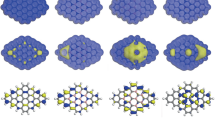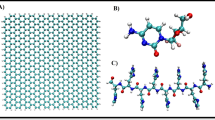Abstract
The application of graphene and related nanomaterials like boron nitride (BN) nanosheets, BN-graphene hybrid nanomaterials, and graphene oxide (GO) for adsorption of anticancer chemotherapeutic camptothecin (CPT) along with the effect on electronic properties prior to functionalization and after functionalization has been reported using density functional theory (DFT) calculations. The inclusion of dispersion correction to DFT is instrumental in accounting for van der Waals π–π stacking between CPT and the nanomaterial. The adsorption of CPT exhibits significant strain within the nanosheets and noncovalent adsorption of CPT is thermodynamically favoured onto the nanosheets. In case of GO, surface incorporation of functional groups result in significant crumpling along the basal plane and the interaction is basically mediated by H-bonding rather than π–π stacking. Docking studies predict the plausible binding of CPT, CPT functionalized graphene and GO with topoisomerase I (top 1) signifying that CPT interacts through π stacking with AT and GC base pairs of DNA and in presence of nano support, DNA bases preferentially gets bound to the basal plane of graphene and GO rather than the edges. At a theoretical level of understanding, our studies point out the noncovalent interaction of CPT with graphene based nanomaterials and GO for loading and delivery of anticancer chemotherapeutic along with active binding to Top1 protein.










Similar content being viewed by others
References
Novoselov KS, Geim AK, Morozov SV, Jiang D, Zhang Y, Dubonos SV, Grigorieva IV, Filrsov AA (2004) Electric field effect in atomically thin carbon films. Science 306:666–669
Gunlycke D, Lawler HM, White CT (2007) Room-temperature ballistic transport in narrow graphene strips. Phys Rev B 75: 085418-1–085418-5
Novoselov KS, Jiang Z, Zhang Y, Morozov SV, Stormer HL, Zeitler U, Maan JC, Boebinger GS, Kim P, Geim AK (2007) Room-temperature quantum hall effect in graphene. Science 315:1379
Zhang Y, Tan Y-W, Stormer HL, Kim P (2005) Experimental observation of the quantum hall effect and Berry’s phase in graphene. Nature 438:201–204
Bolotin KI, Sikes KJ, Jiang Z, Klima M, Fudenberg G, Hone J, Kim P, Stormer HL (2008) Ultrahigh electron mobility in suspended graphene. Solid State Commun 146:351–355
Novoselov KS, Geim AK, Morozov SV, Jiang D, Katsnelson MI, Grigorieva IV, Dubonos SV, Firsov AA (2005) Two-dimensional gas of massless Dirac fermions in graphene. Nature 438:197–200
Ren T, Li L, Cai X, Dong H, Liu S, Li Y (2012) Engineered polyethylenimine/graphene oxide nanocomposite for nuclear localized gene delivery. Polym Chem 3:2561–2569
Feng L, Zhang S, Liu Z (2011) Graphene based gene transfection. Nanoscale 3:1252–1257
Peng C, Hu W, Zhou Y, Fan C, Huang Q (2010) Intracellular imaging with a graphene-based fluorescent probe. Small 6:1686–1692
Yang K, Zhang S, Zhang G, Sun X, Lee S-T, Liu Z (2010) Graphene in mice: ultrahigh in vivo tumor uptake and efficient photothermal therapy. Nano Lett 10:3318–3323
Mohanty N, Berry V (2008) Graphene-based single-bacterium resolution biodevice and DNA transistor: interfacing graphene derivatives with nanoscale and microscale biocomponents. Nano Lett 8:4469–4476
Wang Y, Li Z, Wang J, Li J, Lin Y (2011) Graphene and graphene oxide: biofunctionalization and applications in biotechnology. Trends Biotechnol 29:205–212
Zhao J-X, Yu Y-Y, Bai Y, Lu B, Wang B-X (2012) Chemical functionalization of BN graphene with the metal-arene group: a theoretical study. J Mater Chem 22:9343–9350
Golberg D, Bando Y, Huang Y, Terao T, Mitome M, Tang C, Zhi C (2010) Boron nitride nanotubes and nanosheets. ACS Nano 4:2979–2993
Rubio A, Corkill JL, Cohen ML (1994) Theory of graphitic boron nitride nanotubes. Phys Rev B 49:5081–5084
Azevedo S, Kaschny JR, de Castilho CMC, de Brito Mota FA (2007) A theoretical investigation of defects in a boron nitride monolayer. Nanotechnol 18:495707
Si MS, Xue DS (2007) Magnetic properties of vacancies in a graphitic boron nitride sheet by first–principles pseudopotential calculations. Phys Rev B: Condens Matter Mater Phys 75:193409
Zhang Z, Guo W (2011) Controlling the functionalizations of hexagonal boron nitride structures by carrier doping. J Phys Chem Lett 2:2168–2173
Wei X, Wang MS, Bando Y, Golberg D (2011) Electron-beam-induced substitutional carbon doping of boron nitride nanosheets, nanoribbons, and nanotubes. ACS Nano 5:2916–2922
Li J, Zhou G, Chen Y, Gu B-L, Duan W (2009) Potential room temperature ferromagnetic O/BN and F/BN bilayers. J Am Chem Soc 131:1796–1801
Si MS, Li JY, Shi HG, Niu XN, Xue DS (2009) Divacancies in graphitic boron nitride sheets. Europhys Lett 86(46002):1–6
Wang Y, Ding Y, Ni J (2010) Fluorination-induced half-metallicity in zigzag boron nitride nanoribbons: first-principles calculations. Phys Rev B: Condens Matter Mater Phys 81: 193407 1–4
Zhou J, Wang Q, Sun Y, Jena Q (2010) Electronic and magnetic properties of a BN sheet decorated with hydrogen and fluorine. Phys Rev B: Condens Matter Mater Phys 81(085442):1–7
Tang Q, Zhou Z, Chen Z (2011) Molecular charge transfer: a simple and effective route to engineer the band structures of BN nanosheets and nanoribbons. J Phys Chem C 115:18531–18537
Kotakoski J, Krasheninnikov AV, Ma Y, Foster AS, Nordlund K, Nieminen RM (2005) B and N ion implantation into carbon nanotubes: insight from atomistic simulations. Phys Rev B 71(205408):1–6
Martins TB, Miwa RH, da Silva AJR, Fazzio A (2007) Electronic and transport properties of boron-doped graphene nanoribbons. Phys Rev Lett 98(196803):1–4
Ci L, Song L, Jin C, Jariwala D, Wu D, Li Y, Srivastava A, Wang ZF, Storr K, Balicas L, Liu F, Ajayan PM (2010) Atomic layers of hybridized boron nitride and graphene domains. Nat Mater 9:430–435
Manna AK, Pati SK (2011) Tunable electronic and magnetic properties in BxNyCz nanohybrids: effect of domain segregation. J Phys Chem C 115:10842–10850
Mukhopadhyay S, Scheicher RH, Pandey R, Karna SP (2011) Sensitivity of boron nitride nanotubes toward biomolecules of different polarities. J Phys Chem Lett 2:2442–2447
Mukhopadhyay S, Gowtham S, Scheicher RH, Pandey R, Karna SP (2010) Theoretical study of physisorption of nucleobases on boron nitride nanotubes: a new class of hybrid nano-biomaterials. Nanotechnol 21(165703):1–6
Gowtham S, Scheicher RH, Pandey R, Karna SP, Ahuja R (2008) First-principles study of physisorption of nucleic acid bases on small-diameter carbon nanotubes. Nanotechnol 19(125701):1–6
Gowtham S, Scheicher RH, Ahuja R, Pandey R, Karna SP (2007) Physisorption of nucleobases on graphene: density-functional calculations. Phys Rev B 76:033401–033404
Liu Z, Chen K, Davis C, Sherlock S, Cao Q, Chen X, Dai H (2008) Drug delivery with carbon nanotubes for in vivo cancer treatment. Cancer Res 68:6652–6660
Liu Z, Robinson JT, Sun X, Dai H (2008) PEGylated nano-graphene oxide for delivery of water insoluble cancer drugs. J Am Chem Soc 130:10876–10877
Wang K, Ruan J, Song H, Zhang J, Wo Y, Guo S, Cui D (2011) Biocompatibility of graphene oxide. Nanoscale Res Lett 6:1–8
Zhang X, Yin J, Peng C, Hu W, Zhu Z, Li W, Fan C, Huang Q (2011) Distribution and biocompatibility studies of graphene oxide in mice after intravenous administration. Carbon 49:986–995
di Nunzio MR, Cohen B, Douhal A (2011) Structural photodynamics of camptothecin, an anticancer drug in aqueous solutions. J Phys Chem A 115:5094–5104
Hsiang Y-H, Hertzberg R, Hecht S, Liu LF (1985) Camptothecin induces proteinlinked DNA breaks via mammalian DNA topoisomerase I. J Biol Chem 260:14873–14878
Wall ME, Wani MC, Natschke SM, Nicholas AW (1986) Plant antitumor agents. J Med Chem 29:1553–1555
Jena NR, Mishra PC (2007) A theoretical study of some new analogues of the anti-cancer drug camptothecin. J Mol Model 13:267–274
Gallo RC, Whang-Peng J, Adamson RH (1971) Studies on the antitumor activity, mechanism of action, and cell cycle effects of camptothecin. J Natl Cancer Inst 46:789–795
Ha SW, Kim YJ, Kim W, Lee CS (2009) Antitumor effects of camptothecin combined with conventional anticancer drugs on the cervical and uterine squamous cell carcinoma cell line SiHa. Korean J Physiol Pharmacol 13:115–121
Delley B (1990) An all-electron numerical method for solving the local density functional for polyatomic molecules. J Chem Phys 92:508
Mulliken RS (1934) Electronic structures of molecules. XI. Electro affinity, molecular orbitals and dipole moments. J Chem Phys 2:782–793
Parr RG, von Szentpaly L, Liu S (1999) Electrophilicity index. J Am Chem Soc 121:1922–1924
Frisch MJ, Trucks GW, Schlegel HB, Scuseria GE, Robb MA, Cheeseman JR, Scalmani G, Barone V, Mennucci B, Petersson GA, Nakatsuji H, Caricato M, Li X, Hratchian HP, Izmaylov AF, Bloino J, Zheng G, Sonnenberg JL, Hada M, Ehara M, Toyota K, Fukuda R, Hasegawa J, Ishida M, Nakajima T, Honda Y, Kitao O, Nakai H, Vreven T, Montgomery JA, Jr, Peralta JE, Ogliaro F, Bearpark M, Heyd JJ, Brothers E, Kudin KN, Staroverov VN, Kobayashi R, Normand J, Raghavachari K, Rendell A, Iyengar JC, Tomasi SS, Cossi J, Rega M, Millam NJ, Klene M, Knox JE, Cross JB, Bakken V, Adamo C, Jaramillo J, Gomperts, Stratmann RE, Yazyev O, Austin AJ, Cammi RC, Pomelli JW, Ochterski R, Martin RL, Morokuma K, Zakrzewski VG, Voth GA, Salvador P, Dannenberg JJ, Dapprich S, Daniels AD, Farkas O, Foresman JB, Ortiz JV, Cioslowski J, Fox DJ, Gaussian 09, Revision A.1; Gaussian, Inc.: Wallingford CT, 2009
Liu L, Zeng Z, Zeng G, Chen M, Zhang Y, Zhang J, Fang X, Jiang M, Lu L (2012) Study on binding modes between cellobiose and b-glucosidases from glycoside hydrolase family 1. Bioorg Med Chem Lett 22:837–843
Bursulaya BD, Totrov M, Abagyan R, Brooks CL (2003) Comparative study of several algorithms for flexible ligand docking. J Comput Aided Mol Des 17:755–763
Storn R, Price K (1995) Differential evolution: a simple and efficient adaptive scheme for global optimization over continuous spaces; technical report. International Computer Science Institute, Berkley, CA
Yang J-M, Chen C-C (2004) GEMDOCK: a generic evolutionary method for molecular docking. Proteins 55:288–304
Zhao Y, Wu X, Yang J, Zeng XC (2011) Ab initio theoretical study of non-covalent adsorption of aromatic molecules on boron nitride nanotubes. Phys Chem Chem Phys 13:11766–11772
Acknowledgments
The authors thank the Department of Science and Technology (DST), New Delhi, India for funding the project.
Author information
Authors and Affiliations
Corresponding author
Electronic supplementary material
Below is the link to the electronic supplementary material.
Rights and permissions
About this article
Cite this article
Saikia, N., Deka, R.C. Ab initio study on the noncovalent adsorption of camptothecin anticancer drug onto graphene, defect modified graphene and graphene oxide. J Comput Aided Mol Des 27, 807–821 (2013). https://doi.org/10.1007/s10822-013-9681-3
Received:
Accepted:
Published:
Issue Date:
DOI: https://doi.org/10.1007/s10822-013-9681-3




